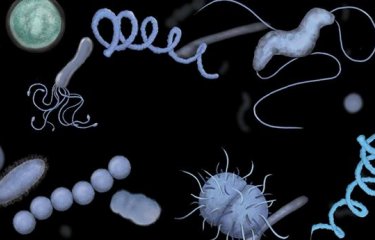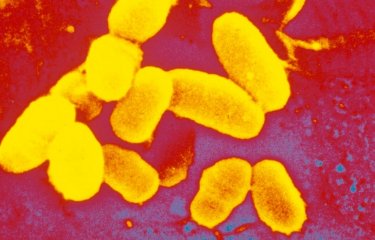Some strains of the bacterium Listeria monocytogenes are capable of producing an antibiotic molecule that enables them to kill other bacteria with which they come into direct contact.
Although everyone knows about antibiotics, which we take to tackle bacterial infections, we tend not to realize that some bacteria are capable of producing antibiotics themselves! This is the case for some particularly virulent strains of the bacterium Listeria monocytogenes, which causes listeriosis. These strains are capable of producing a peptide, Listeriolysin S, which has antibiotic properties. However, Listeria monocytogenes does not release the molecule in its environment; it only uses it when it comes into contact with other bacteria. This was revealed by a study conducted by several teams from INRAE, Inserm and the Institut Pasteur, including the Yersinia research unit led by Javier Pizarro-Cerdá, the results of which were published in the journal PNAS.
Targeted action to modulate the composition of the microbiota
In the gut of mammals, Listeria is capable of expressing Listeriolysin S at its surface. The molecule weakens the membrane of some bacterial species with which it comes into contact, causing them to die. "Some of our preliminary results suggest that Listeriolysin S is a very hydrophobic molecule, meaning that it is insoluble in water. If Listeria comes into contact with sensitive bacteria, Listeriolysin S can therefore move directly from the Listeria membrane to the membrane of the sensitive bacteria and does not have to go through the external liquid environment", explains Javier Pizarro-Cerdá. This shows that Listeria is capable of modulating the composition of the gut microbiota so that it faces less competition from other bacteria and is better able to infect the gut and also deep organs like the liver or the spleen. Listeriolysin S is therefore associated with the high virulence of the strains that produce it.
A rare strategy in the bacterial world
The contact-dependent activity of Listeriolysin S is a novel discovery, since it is a rare strategy in the bacterial world. By not releasing the molecule into the environment, Listeria prevents other bacteria from potentially benefiting from the presence of Listeriolysin S. "What's more, adds Javier Pizarro-Cerdá, Listeria will only kill those bacteria that benefit from the same environment and the same resources as it does. It only kills bacteria located close to it, rather than wasting its resources producing a molecule that could go further afield and kill other bacteria."
This unprecedented breakthrough was made possible by the use of advanced microscopy techniques in collaboration with the Microbial Individuality and Infection Unit, the Imaging and Modeling Unit, the Ultrastructural BioImaging Platform (UTechS UBI) and the Institut Pasteur's Image Analysis Hub.
Listeriolysin S: A bacteriocin from Listeria monocytogenes that induces membrane permeabilization in a contact-dependent manner, PNAS, october 1, 2021
Jazmín Meza-Torresa,b,c, Mickaël Lelekd, Juan J. Queredae, Martin Sachsef, Giulia Maninag, Dmitry Ershovh,i, Jean-Yves Tinevezh, Lilliana Radoshevichj, Claire Maudetk, Thibault Chazel, Quentin Giai Gianettol,m, Mariette Matondol, Marc Lecuitc,k,n, Isabelle Martin-Verstraeteo, Christophe Zimmerd, Hélène Biernep, Olivier Dussurgeta,c, Pascale Cossartb, Javier Pizarro-Cerdáa
a - Yersinia Research Unit, Microbiology Department, Institut Pasteur, 75015 Paris, France ;
b - Bacteria-Cell Interactions Unit, Cell Biology and Infection Department, Institut Pasteur, 75015 Paris, France ;
c - Université de Paris, Sorbonne Paris Cité, 75005 Paris, France ;
d - Imaging and Modeling, Department of Computational Biology, Institut Pasteur, Centre National de la Recherche Scientifique, Unité Mixte de Recherche 3691, 75015 Paris, France ;
e - Departamento Producción y Sanidad Animal, Salud Pública Veterinaria y Ciencia y Tecnología de los Alimentos, Facultad de Veterinaria, Universidad Cardenal Herrera-CEU,CEU Universities, 46115 Valencia, Spain ;
f - Ultrastructural BioImaging, Institut Pasteur, 75015 Paris, France ;
g - Microbial Individuality and Infection Group, Cell Biology and Infection Department, Institut Pasteur, 75015 Paris, France ;
h - Image Analysis Hub, C2RT, Institut Pasteur, 75015 Paris, France ;
i - Bioinformatics and Biostatistics Hub, Department of Computational Biology, Institut Pasteur, Centre National de la Recherche Scientifique, Unité de Service et de Recherche3756, 75015 Paris, France ;
j - Department of Microbiology and Immunology, Carver College of Medicine, University of Iowa, Iowa City, IA 52242 ;
k - Biology of Infection Unit, Institut Pasteur, Institut National de la Santé et de la Recherche Médicale Unité 1117, 75015 Paris, France ;
l - Proteomics Platform, Mass Spectrometry for Biology Unit, Institut Pasteur, Centre National de la Recherche Scientifique, Unité de Service et de Recherche 2000, 75015 Paris, France ;
m - Bioinformatics and Biostatistics HUB, Computational Biology Department, Institut Pasteur, Centre National de la Recherche Scientifique, Unité de Service et de Recherche 3756, 75015 Paris, France ;
n - Division of Infectious Diseases and Tropical Medicine, Necker-Enfants Malades University Hospital, Institut Imagine, Assistance Publique-Hôpitaux de Paris, 75004 Paris, France ;
o - Laboratoire Pathogenèses des Bactéries Anaérobies, Institut Pasteur, Centre Nationalde la Recherche Scientifique, Unité Mixte de Recherche 2001, Université de Paris, 75015 Paris, France ;
p - Epigenetics and Cellular Microbiology Laboratory, Université Paris-Saclay, Institut National de Recherche pour l’Agriculture, l’Alimentation et l’Environnement, AgroParisTech, 78352 Jouy-en-Josas, France





